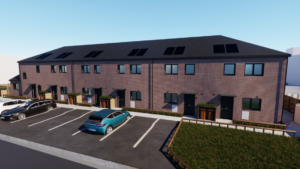Could the 216,000 empty homes in the UK be the answer to the homeless crisis?

Chris Bailey of the charity Action on Empty Homes spoke to New Start about whether the massive numbers of empty houses in the UK could offer a solution to the homeless crisis.
Many people look at an empty home in their neighbourhood and think it could be used to house the homeless – is this realistic or practical?
Yes, but it isn’t as easy as it could or should be.
Traditionally, ‘an Englishman’s home is his castle’, right? Although people are starting to question whether it’s a home if no one is living in it.
The government has empowered local councils to charge double Council Tax on long-term empty homes. But this only kicks in after two years declared empty. Furthermore not all empty homes are empty because their owners really want them kept that way. Many could be brought into use if incentives or grants were on the table to modernise them.
Schemes which do this do exist, either through councils, charities or specialist housing providers (such as those Action On Empty Homes works with around the country in our Demonstration Projects programme).
In return for investment, either as a grant or loan, such schemes tie those homes into the alleviation of housing need for a period. But these schemes exist in only a small number of areas. This is because there is no longer any central government funding to do this after the last national Empty Homes Programme closed in 2015.
Some councils use powers such as Empty Dwelling Management Orders (EDMOs), effectively an enforced version of the schemes discussed above. But they bemoan the time, effort and uncertainty of this process, dependent as it is on proving that the property is damaging the local area by being empty; and open as they are to challenge at Residential Property Tribunals by owners. This means that EDMOs are not always granted to councils after all the work has gone into compiling a case. Some councils are lobbying for these powers to be made easier and quicker to exercise and tougher to appeal against.
Returning empty property to use does cost money, the last government programme returned over 9,000 properties to use for an investment of about £24,000 per home on average. But that was money well spent, good value for government, for those in housing need who benefited and for the neighbourhoods which saw reduced blight from empty homes.
The number of empty homes and the number of people homeless in the UK has risen at the same time — why, and are they linked?
The number of long-term empty homes reached 216,000 in 2018 and is now rising at the fastest rate for a decade, up nearly 11,000 this year, a 5% increase. This is double the rate of increase last year.
Homelessness is also rising, so are social housing waiting lists (at 1.1m). Numbers of people in temporary accommodation is also at a ten-year high, over 82,000 households including 120,000 children, and over 26,000 families are in ‘out of borough’ temporary accommodation – this disrupts lives, destroys both formal and informal support networks and often creates additional difficulty in securing employment.
So are these related? The short answer is ‘yes’; and here’s how —
We have a national housing crisis of supply, affordability and quality.
Furthermore, we spend £9bn of our £23bn housing benefit bill in the Private Rented Sector (PRS), where standards applied to social homes do not apply. This means that in far too many cases we are spending good money on bad housing.
Social housing rents are on average far cheaper than PRS rents. Which is why everyone, from the Conservative-led Local Government Association to Shelter and the National Housing Federation, says that we need to build more social housing.
We also spend £1bn a year on Temporary Accommodation (TA) which is by definition, insecure, inappropriate and often overcrowded – it is also often delivered in the PRS and in many cases out of the ‘home’ Borough of those declared homeless (and who ironically enough are often made homeless as the result of no-fault evictions from the PRS under the hated Section 21 of the Housing Act).
There’s a word for that and the obvious one, to misquote Dizzee Rascal, it is ‘bonkers’ – so who benefits from that? Not those families, not their children and not our country.
While government laments its failure to hit its annual new build target of 300,000 homes by over 25 disastrous percent; all the experts say we need 90,000 extra social homes a year as part of a target of maybe 340,000 (that’s over 10% higher than the one which government missed).
Bad huh? But it gets worse because guess how many of those 90,000 social homes which we need were built last year — 6,400.
Very bad, right? But there is a reason this is called a housing crisis by everyone from the government to the Monster Raving Loony Party; and it’s this — last year we sold 20,000 social homes so we actually ended the year with over 13,000 less than we started the year with. That is, in anyone’s language, a housing crisis. And it is also ‘bonkers’ too.
Then we have the empty homes 216,000 of them long-term empty (plus another 246,00 less than six months empty; and a further 252,000 second homes) – meaning that around 1 in 30 English homes currently has no resident, what exactly do we call that? – I won’t say the B word again, or it’s going to sound like a tune… but not a very happy one.
Which local authorities use empty homes to house the homeless?
A good example of a recent pilot is Durham who has just taken a decision to invest in doing exactly this. But good as it is to see Durham act in this way (and it is by no means the only council doing this), Durham has thousands of empty homes and much more investment is needed – the kind of area-focused regeneration funding that only government can supply. This is why the National Coalition for Community Investment, which Action on Empty Homes coordinates, advocates this.
The Coalition involves organisations from across the housing sector, members include: private landlords groups such as the Residential Landlords Association; social and affordable housing providers like the National Housing Federation, Northern Housing Consortium and National Community Land Trusts Network; and campaigning organisations like Action on Empty Homes, Crisis and Shelter; as well as representative bodies such as the Propertymark (incorporating the National Association of Estate Agents and the Association of Residential Letting Agents), the Federation of Master Builders and Locality.
Does the current government have a grip on the homeless crisis?
I think that given the evidence cited, and discussion above, we can safely say — no, and I feel that everyone in the sector would agree with us.
At Action on Empty Homes we wholeheartedly support the campaign to build social housing but this is not happening fast enough. In fact, as discussed above, it is not, in any real sense, happening at all. Because we keep ending each year with less social housing than we started the year with. And all the time England’s empties keep piling up, while housing benefit and temporary accommodation bills escalate.
Increasing supply across all tenures is crucial to ending the housing crisis – but so is making the best use of existing empty homes. These can in many cases be brought into use relatively quickly, with planning delays rare or non-existent. Yet, since 2015, there has been no dedicated government funding for areas with high levels of empty homes.
We think it is time that the government did the maths and invested in areas with high levels of empty homes and used that housing to alleviate housing need. It is simply not true that these homes are ‘in the wrong places’ as some commentators have suggested.
We have housing need everywhere, in rural areas and urban ones, in high-value areas and low-value areas. There are people living on the streets of Northern towns and cities and there are people living on the streets of London and other Southern towns and cities. This should be seen as low-hanging fruit and it is about time government picked it.















